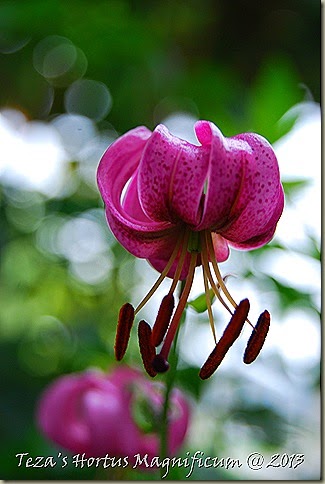Aconitum x cammarum ‘Stainless Steel’
Aconitum is the Latin term for an ancient name used by Theophrastus for a poisonous herb. All parts of this magnificent plant are poisonous when ingested – its root extract was used to poison wolves, a scourge of European farmers. [hence the epitaph wolfsbane] Aconitum napellus, the classic European species has served as a source of aconite, a heart sedative.
Most members of this genus are listed as perennial and are further divided into those that remain for the most part erect in stature, and those that climb. As a collector, I cannot urge strongly enough the need to have both forms in your garden! I am always amazed at the number of people who comment to the fact that the majority of mine are grown in a partially shaded location – most books list them as preferring full sun. They make wonderful additions to the woodland garden, with colours ranging from pure white, bicolour, pink, yellow, blue and purple!
Aconitum is native to the northern temperate regions of North America and Eurasia, and dislike the warm temperatures zones – not being suitable for areas where summer night temperatures exceed 21 Celsius for extended periods. This is essentially why mine are grown in partially shaded, protected sites! The majority of plants are hardy between Zones 3-6. Morphologically speaking, the majority of species are usually characteristically similar: flowerstalks 0.9-1.2m in height, with helmet shaped flowers that appear well above the foliage, commonly held in racemes or panicles to 60cm in length. Most of the flowers are between 2.5-5cm in length and have five sepals, the upper which is enlarged and shaped like a helmet, with 5 petals, the upper pair shaped like spurs and included in the hood, the lower triplet insignificant or absent altogether in some species. Foliage is often divided fingerlike, and is lobed or cleft. IN most species this foliage clothes the lower half of the stem.
![DSC_0211[3] DSC_0211[3]](https://blogger.googleusercontent.com/img/b/R29vZ2xl/AVvXsEjXAWMWTNcCGUo2zy51FLjOBwOMpXg4byeTe2xpyf0WLcO9L3q5HPYGD5UnZ9xuPfxkZfpiXkBZcOdf6rB3j-LfEFNU21M4GZWnCFCYazNkyy-z90JjLMDgvJi4TYXkJFufUrsuk02cPMbF/?imgmax=800)
I adore all of the species that I grow and have recently acquired a second climbing species to accompany the one in the photo above which is the native Aconitum uncinatum, a most delightful climber whose wonderful helmet shaped flowers are readily visible as it clamors around an iron obelisk in the Shaded Walk. The new species, A. austroyunnanense, from Lost Horizons, is described by plantsman and proprietor Larry Davidson as being, ‘… a rare climbing species from China where it twines itself up shrubs or scrambles over boulders with large palmate leaves. Long stemmed, rich blue tinged with purple helmets appear in late July.’
There are a few that I would like to add this year, including A.ferox, A.incisofidum and A.alboviolaceum, another climber with Pope’s mitre shaped flowers that are white tinged with pink! Are the wolves howling at your door as well?



![DSC_0626_thumb[3] DSC_0626_thumb[3]](https://blogger.googleusercontent.com/img/b/R29vZ2xl/AVvXsEhbrSgqka_PtbgkJUnW4zFmQ3YXW1zXRz_bi4iWK1fN-6wOTf8-wLfwBacmBDZ80ACL64dZFZHKHAqhXMwphgJHPQ1Oan_Ds4Mp-lulUEJcTED8HVrmwgW2k-2pMDDYfpyrRvcqSf14N0mm/?imgmax=800)


































No comments:
Post a Comment